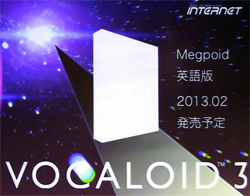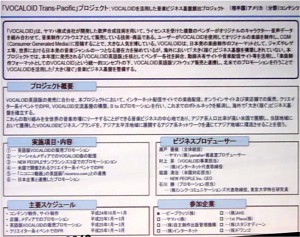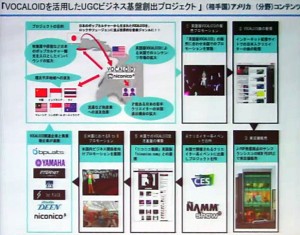 A new initiative titled ?VOCALOID Trans-Pacific Project? (not to be confused with the more heinous Trans-Pacific Partnership) was unveiled at DC Expo a few days ago. DC Expo (short for Digital Content Expo) is ?an international event intended to shape the future of [the digital content] industry five or ten years into the future as well as promote the exchange of the latest information between participating researchers, creators and businesspeople active in this field.? According to a talk segment (recording available on Ustream) involving INTERNET, Bplats and Yamaha, the project aims to spread the creative culture behind VOCALOID to the US and eventually throughout Asia. INTERNET Co. Ltd. also unveiled a tentative release date of February 2013 for the English version of megpoid. This is the third year VOCALOID was featured at DC Expo, with simple demonstrations of the software and LiveAR performances held previously.
A new initiative titled ?VOCALOID Trans-Pacific Project? (not to be confused with the more heinous Trans-Pacific Partnership) was unveiled at DC Expo a few days ago. DC Expo (short for Digital Content Expo) is ?an international event intended to shape the future of [the digital content] industry five or ten years into the future as well as promote the exchange of the latest information between participating researchers, creators and businesspeople active in this field.? According to a talk segment (recording available on Ustream) involving INTERNET, Bplats and Yamaha, the project aims to spread the creative culture behind VOCALOID to the US and eventually throughout Asia. INTERNET Co. Ltd. also unveiled a tentative release date of February 2013 for the English version of megpoid. This is the third year VOCALOID was featured at DC Expo, with simple demonstrations of the software and LiveAR performances held previously.
Preliminaries
At the venue, the projector first played back related footage from previous years of DC Expo, including shots of HRP-4C MIMU as well as a LiveAR performance featuring Akikoloid-chan and GUMI dancing to Aoi Konbini de Aimashou and Megane no Mukou no Sekai. The video concluded with a series of on screen messages: ?2012?, ?VOCALOID meets Cool Japan? and ?VOCALOID Trance[sic]-Pacific Project?. After the video showing, four panelists walked on stage, apologizing for being just a group of old men.
After everyone sat down, the panel chair, Masaru Ishikawa, talked briefly about what was shown on screen. He also mentioned that this was the third year VOCALOID was featured at DC Expo and a new project will be unveiled. Ishikawa then invited the rest of the panel to introduce themselves: Noboru Murakami from INTERNET, Takuma Miyazaki from Bplats and Osamu Ohshima from Yamaha. Finally, Ishikawa introduced himself as a researcher from University of Tokyo working in the Information and Robot Technology Research Initiative.
With introductions finished, Ishikawa summarized the aim and content of this talk show. This Trans-Pacific Project is essentially a collaboration between VOCALOID and the Cool Japan Project, the latter aiming to spread culture based on Japanese creative works as well as related industries throughout the world. The title ?Trans-Pacific? was intended to convey the idea of crossing the Pacific and spreading VOCALOID culture over to the US, as well as to other Asian countries over time.
Bplats?s Yamazaki noted that there actually hasn?t been a VOCALOID product native to North America yet. Yamaha?s Ohshima then clarified that although there are several English VOCALOID sound banks, none of them originated in North America. Having one come out of the US would require a suitable business partner.
What is VOCALOID?
Before going further, the panel wanted to describe in more detail what VOCALOID is. Ohshima stated that while VOCALOID is simply vocal synthesis technology to Yamaha, people began writing songs with VOCALOID and others started drawing artwork, resulting in VOCALOID spreading far and wide.
As far as business was concerned, the biggest role Yamaha plays is the development of the technology and its licensing to business partners. One such licensee is INTERNET, which creates the voice banks and packages the two together into a product. Meanwhile, companies like Bplats operate in the background and handle the logistics of eventually setting up a product on a store shelf.
However, the panelists stated that VOCALOID embodied more than simply the business aspect. In fact, a ?VOCALOID culture? as developed. One example given was a specific LiveAR showing outside a train station in Japan. Footage on the projector showed animated computer generated models of Tone Rion, Akikoloid-chan and GUMI dancing with the crowd, while Cyber Thunder Cider played in the background. This event was held outside of Seibushinjuku Station, and the original camera footage was combined with the 3D models using augmented reality techniques and then displayed on giant YUNICA VISION screens. Some of the people in the crowd didn?t really know what was going on, but a lot of them were happily partying along. Ohshima mentioned that perhaps this could be expanded into a digital signage business and also stressed that the music was created by ?normal? creators. In a way, he said, this was like a guerrilla concert. Ishikawa noted that while people of his generation probably don?t have a very good idea of VOCALOID, younger generations, especially those in their teens, are very familiar with VOCALOID; VOCALOID songs consistently score very high on song popularity rankings for karaoke.
VOCALOID through INTERNET, Bplats and Yamaha
With an overview of VOCALOID and its culture out of the way, the panelists wanted to then go into more detail about their respective businesses. Murakami started by going over the release history of his company?s VOCALOID products, starting with the VOCALOID2 releases. He noted that although he started with sound banks recorded by singers, for some reason they also decided to release Gachapoid. Murakami then moved onto giving an overview of INTERNET?s VOCALOID3 releases, at which point one of the panelists wondered if there were perhaps multiple copies of him, since he worked personally on all these databanks. The slides then ended up with a shot of a white product box, stating that megpoid English had a tentative February 2013 release date. Apparently this information hadn?t even been sent out via press releases yet, so this was considered an ?unofficial announcement?. According to Murakami, the recording for this sound bank had already been finished, and the panelists started discussing the differences between Japanese and English sound banks.
Apparently, while Japanese sound banks have approximately 500 or so phonemes, English has approximately 5 times the amount. However, unfortunately while the work is greatly magnified, they obviously couldn?t raise the price and still expect it to sell, and thus one panelist quipped that Murakami had to take a pay cut (in terms of income per phoneme). According to him, it also takes approximately three to four times as long to record the audio for the English sound bank.
Murakami then moved on to promote his company?s upcoming Singer Songwriter (SSW) 10 product, with a scheduled release date of November 9. He noted that although VOCALOID can provide the vocals, songs still needed backing instrumentation, which is where digital audio workstation (DAW) software such as SSW came in. Although VOCALOID3 stopped supporting ReWire (and thus direct synchronization with DAW software), SSW 10 claims to be able to synch with VOCALOID through the use of a VST plugin that VOCALOID3 Editor would load. This plugin sounds very much like V3Sync, a third-party plugin which let VOCALOID3 Editor talk with other DAW packages.
After Murakami?s overview of INTERNET, Ohshima proceeded to give an overview of the recently-released VocaListener, touted as a tool which can be used to copy the singing style of a vocalist from a recording. As an example, he showed GUMI copying Kaori Mochida?s performance of Every Little Thing, which was originally to demonstrate MIMU, but the MIMU voice bank isn?t publicly available. He noted that the provided vocals unfortunately had some reverb and thus VocaListener got confused by it, making the result kind of strange. VocaListener?s distribution is handled by Bplats.
And with that segue, Yamazaki went over what Bplats was about. Bplats provides many services, including cloud service brokerage and conversion assistance. However, Bplats also handles distribution of VOCALOID products. The company was involved with the CloudVST project (which enabled usage of VST plugins through the cloud) as well as the VOCALOID STORE, VOCALOID CHINA and the distribution of VOCALOID3 products. Recently, Bplats started a new label called VOCALOID MUSIC PUBLISHING (VMP), which aims to help VOCALOID artists distribute their music. Although not mentioned during the panel, Bplats was involved in the distribution of galaco and encouraged downloaders to sign up with VMP. VMP then sent out emails recently about their service, which submitted songs to various digital distribution platforms for a 50% cut of the revenue (after the distribution platforms take their cut).
VOCALOID Trans-Pacific Project ? Slide 1
 At this point the panelists realized they may have dwelt too long on preliminaries and moved on to talk more about the Trans-Pacific Project. A giant word-packed slide was shown on the screen detailing the project.
At this point the panelists realized they may have dwelt too long on preliminaries and moved on to talk more about the Trans-Pacific Project. A giant word-packed slide was shown on the screen detailing the project.
This first slide talked about one aspect of the VOCALOID Trans-Pacific project ? setting up a foundation for a VOCALOID-using music business in America. The slide gives a background on VOCALOID as well as the lack of a basis for VOCALOID music in America, which is where the project would come in. The project aims to break down previous bottlenecks to establish the basis for a ?very profitable? [VOCALOID music] business outside Japan. This will be accomplished through digital distribution of music, sales through both online and retail channels, promotions during events attended by music creators, construction of a foundation for interchange through VOCALOID as well as business-to-business marketing, all timed to coincide with the release of English sound banks for VOCALOID. These measures will be enacted in America, with its high Asian population and being the epicenter of a music business with global reach. The fruits of this endeavor would then be circulated through Asian cultural networks in the Asia Pacific region. The actual plan involves the following specific actions:
- Promotion of the sale of English VOCALOID
- Distribution of VOCALOID music through social media
- Promotion at New People in San Francisco
- Marketing and promotion at events in the US attended by music creators
- Partnership with the English version of niconico, niconico.com [though that has technically merged with niconico proper already]
- Promotion in collaboration with Japanese businesses
The main parties (or ?producers?) involved with bringing this to fruition are: Yuki Seto (producer from Yamaha?s yamaha+ Promotion House) as overall lead, Noboru Murakami (CEO of INTERNET Co., Ltd.) to handle VOCALOID software, Seiji Horibuchi (CEO of NEW PEOPLE Inc.) to handle relations with the American side, and Masaru Ishikawa (CEO of think.communications and Specially Appointed Researcher at Tokyo University) to handle marketing and promotion.
The project?s primary schedule consists of the following:
- From October 2012 to January 2013: content and website creation
- From January 2013 to March 2013: Promotion both at retail outlets and through the media
- From January 2013 to March 2013: Promotion for the sales of English VOCALOID
- From January 2013 to March 2013: Promotion and marketing at creator-oriented events [e.g. conventions/conferences]
Lastly, the main slide provided a list of participating companies. They are: Bplats, Inc., Yamaha Corporation, UGC Publishing, Inc., INTERNET Co., Ltd., AHS Co. Ltd., 1st PLACE Co.,Ltd., STUDIO DEEN CO.,Ltd. and DWANGO Co.,Ltd.
VOCALOID Trans-Pacific Project ? Slide 2
 A second slide illustrates a second part of the project, with ideas aimed at creating a foundation for businesses rooted in VOCALOID user-generated content. In other words, the planners wish to elevate VOCALOID as a genre to a level commensurate with genres well known all over the world, like rock and fusion. They break this aim up into five smaller goals:
A second slide illustrates a second part of the project, with ideas aimed at creating a foundation for businesses rooted in VOCALOID user-generated content. In other words, the planners wish to elevate VOCALOID as a genre to a level commensurate with genres well known all over the world, like rock and fusion. They break this aim up into five smaller goals:
- Increase inbound Japanese pop-culture tourism traffic to Akihabara and Harajuku.
- Increase the media content market in America via English VOCALOID.
- Increase opportunities for talented young Japanese creators to debut in America.
- Ripple effects affecting distribution and other businesses.
- Ripple effects emanating towards the Pacific rim, including countries such as China, Indonesia, Thailand, Malaysia, Singapore and Australia.
They also detail several more specific plans:
- Promotion timed to coincide with release of an English VOCALOID [with a picture of GUMI surrounded by glowsticks].
- Distribution of VOCALOID music ? Broadcast of music by Japanese creators through internet streaming sites [with a flipped picture of YouTube].
- Sales through brick and mortar outlets ? sales of physical product through NEW PEOPLE in San Francisco, a beachhead for J-Pop.
- Promotion of the project at creator-aimed events, including International CES and the NAMM Show.
- Constructing a foundation for VOCALOID interchange in America ? collaboration with the English version of niconico on niconico.com.
- Business to business marketing in America.
This project will involve the participation of both VOCALOID-related and unrelated businesses, such as Bplats, Yamaha, INTERNET, AHS, 1st PLACE, STUDIO DEEN and niconico.
VOCALOID Trans-Pacific Project ? Discussion
While the slides were running, the panelists commented on them, mentioning January events in Las Vegas (CES) and Anaheim (NAMM). Murakami stated that his biggest goal was for American creators to use megpoid English. Yamazaki noted that Bplats will be providing the distribution infrastructure required. He also played a curious clip of a demo song sung in three different languages. SeeU sang the Japanese and Korean versions of Kimpaksa?s ?Alone? (lyrics by 45 degrees), with Luo Tianyi covering the Chinese version of the song. The panelists agreed that usually, there are two types of people who enjoy VOCALOID ? those who like it in Japanese and those who?d like to experience it in their own native language, and they note that America is likely like that as well. Ohshima commented that Yamaha is known internationally for their musical instruments and they would also like for VOCALOID creativity to bloom as well.
Finally, Ishikawa added that he is happy that VOCALOID is getting more popular in America. However, he wants the idea of VOCALOID as a musical instrument to spread more and want users to make new media using VOCALOID and spread them on content sharing websites, getting fans to comment on them, etc. Without this cycle, he feels that the VOCALOID phenomenon in Japan wouldn?t be able to be replicated elsewhere. He would like the business process of nurturing VOCALOID in Japan to expand step by step into America.
And with about 20 seconds left on the clock, the panelists said the closings to conclude the panel.
Source: http://www.vocaloidism.com/vocaloid-trans-pacific-project-unveiled/
hologram pulitzer prize winners nfl 2012 schedule gmail down ryan oneal file taxes online tupac shakur
No comments:
Post a Comment
Note: Only a member of this blog may post a comment.